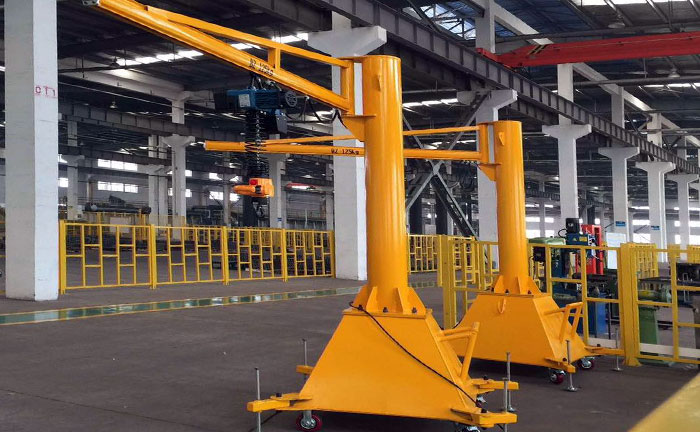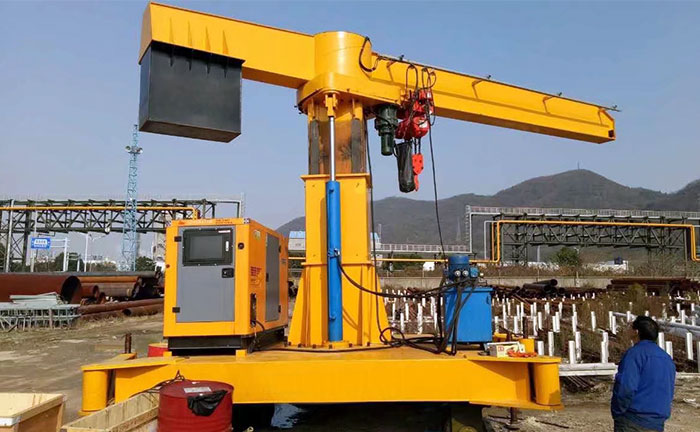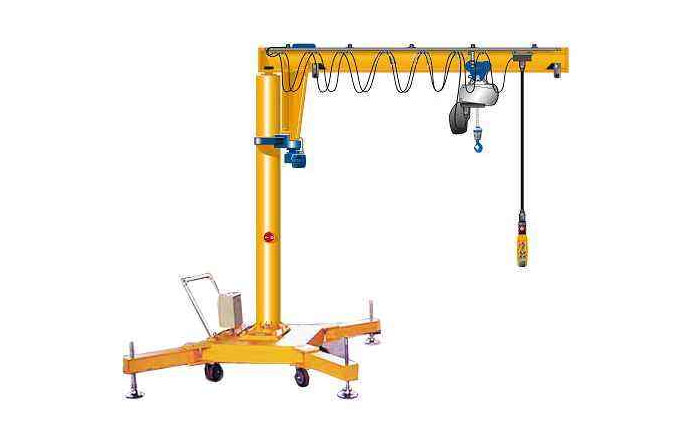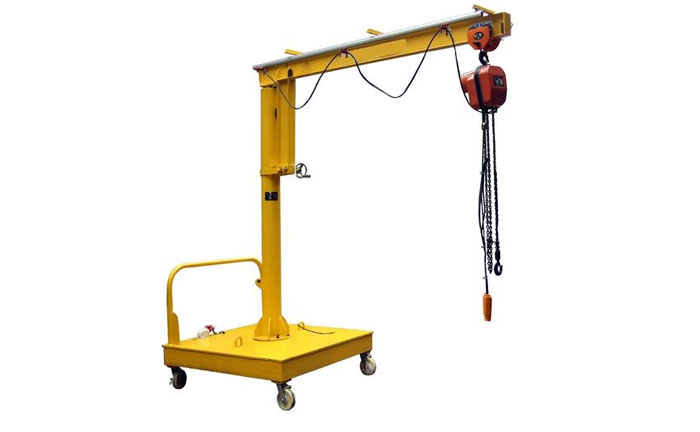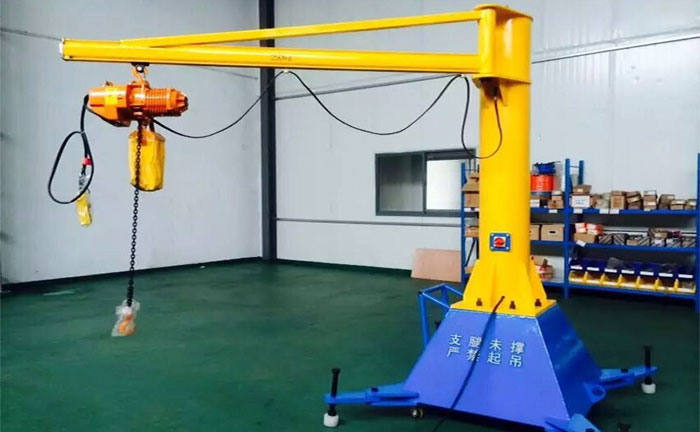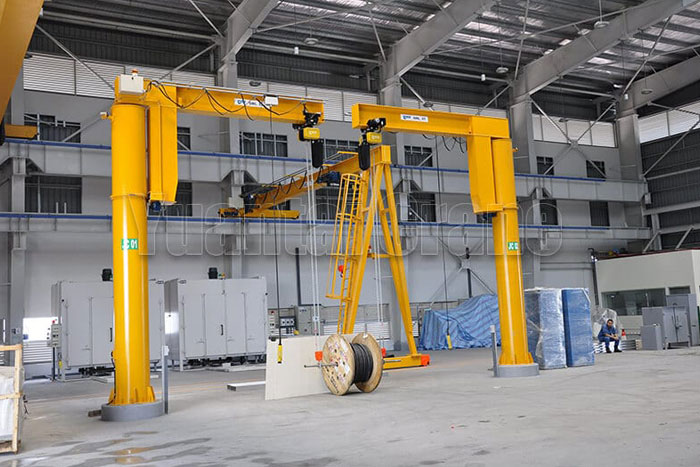Ton Jib Crane & Price
Mobile Jib Crane
Lifting Capacity: 0.25t / 0.5t / 1t / 2t ton
Span: 1~3 m
Lifting Height: 1~3 m
Working Class: A3
Note: We can design and manufacture the crane according your requirments and working conditions.
Mobile jib crane also known as a portable jib crane, is a type of lifting equipment used to move heavy loads horizontally and vertically within a relatively small area. It consists of a vertical support post, a horizontal boom (jib), and a hoist or winch system. What makes it "mobile" is that portable jib crane is on wheels or casters, allowing it to be easily moved to different locations within a workspace or facility.
Mobile jib crane specification:
- Lifting Capacity: 0.25t / 0.5t / 1t / 2t
- Lifting Height: 1~3m / customized
- Rotation radius: 1~3m / customized
- Angle of rotation: 270° / 360°
- Rotary way: manual / electric
- Working class: A3
- Power supply: 220-480V 3Phase 50/60Hz
Mobile jib crane structure and components parts:

Mobile portable jib crane on wheels types:
Mobile jib crane with electric wire rope hoist
Mobile jib crane with electric motor driven rotating
Mobile jib crane with counter balanced weight
Mobile jib crane design with light crane
Mobile jib crane features and characteristics:
- Mobility: Portable jib crane on wheels or casters, making it easy to transport and position in various areas of a factory, workshop, or construction site.
- Versatility: Mobile portable jib crane on wheels are versatile and can be used for a wide range of lifting and material handling tasks. They can rotate 360 degrees, allowing for precise positioning of loads.
- Compact Design: Portable jib crane on wheels are typically designed to take up minimal floor space while providing maximum lifting capacity.
- Lifting Capacity: Mobile portable jib crane on wheels come in various sizes and lifting capacities, ranging from a few hundred pounds to several tons, depending on the specific model.
- Hoist Options: They can be equipped with different types of hoists or winches, such as electric chain hoists or wire rope hoists, to suit the lifting requirements.
- Ease of Use: Mobile portable jib crane on wheels are relatively easy to operate, making them suitable for a variety of applications. They are often controlled by a remote pendant or a control panel.
- Portability: Portable jib crane on wheels portability allows them to be used for tasks like loading and unloading trucks, moving heavy machinery, assembling products, and more.
- Stability: Mobile portable jib crane on wheels typically have a counterweight or outriggers to provide stability during lifting operations.
Mobile jib crane use precautions:
Using a mobile jib crane safely and effectively is crucial to prevent accidents, protect workers, and ensure efficient material handling operations.- Operator Training: Ensure that the crane operator is properly trained and certified to operate the mobile portable jib crane on wheels. They should be familiar with the crane's controls, limitations, and safe operating procedures.
- Pre-Operation Inspection: Before each use, conduct a thorough pre-operation inspection of the mobile portable jib crane on wheels to check for any damage, wear, or mechanical issues. Ensure that all components, including cables, hooks, and controls, are in good working condition.
- Load Capacity: Always adhere to the crane's rated load capacity, which should be clearly indicated on the crane. Overloading the crane can lead to equipment damage and accidents.
- Clearance: Ensure there is adequate clearance both vertically and horizontally when moving loads. Be mindful of overhead obstructions, walls, and other equipment in the vicinity.
- Stability: Verify that the crane is set up on a stable and level surface. Some portable jib crane on wheels have outriggers or stabilizing legs that should be properly deployed to ensure stability during lifting operations.
- Boom Positioning: Position the crane's boom (jib) carefully to avoid swinging or unintended movement of the load. Use smooth and controlled movements to prevent sudden shifts in load position.
- Weather Conditions: Consider weather conditions when operating the crane. High winds, rain, or other adverse weather conditions can affect stability and safety. Avoid operating the crane in extreme weather conditions if possible.
- Regular Maintenance: Perform regular maintenance on the mobile portable jib crane on wheels as recommended by the manufacturer. This includes lubrication, inspections, and addressing any wear and tear promptly.
Mobile jib crane safety protection system:
- Overload Protection: Overload protection systems are designed to prevent the crane from lifting loads that exceed its rated capacity. When the load approaches or exceeds the safe limit, the system may trigger an alarm, slow down the crane's movements, or even stop the operation to avoid overloading.
- Emergency Stop Button: An emergency stop button or switch should be easily accessible to the crane operator. It allows for the immediate cessation of all crane movements in case of an emergency or when unsafe conditions are detected.
- Limit Switches: Limit switches are used to define safe working zones for the crane's movements, both horizontally and vertically. When the crane approaches these limits, the switches can automatically cut off power to prevent the crane from traveling or lifting beyond the safe boundaries.
- Anti-Collision System: Mobile portable jib crane on wheels working in shared spaces with other crane or equipment can benefit from anti-collision systems. These systems use sensors and algorithms to detect potential collisions and automatically halt crane movements or provide warnings to the operator.
- Slew Locking Device: This device ensures that the crane's jib remains stationary and locked in place when not in use. It prevents unintended jib movement, especially when the crane is being transported or when it is parked.
- Emergency Lowering System: In the event of a power failure or equipment malfunction, an emergency lowering system allows the operator to safely lower the load to the ground, avoiding uncontrolled drops.
- Load Moment Indicator (LMI): An LMI provides real-time feedback on the crane's load status, helping the operator make informed decisions regarding load capacity and stability. It can prevent overloading and tip-over accidents.
- Safety Interlocks: Safety interlocks ensure that specific conditions are met before the crane can operate. For example, the crane may require proper outrigger deployment or confirmation of load attachment before lifting.
Previous: Sorry no more

